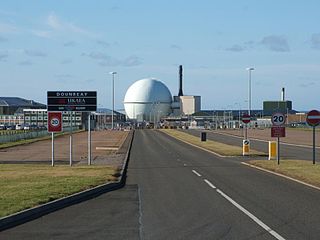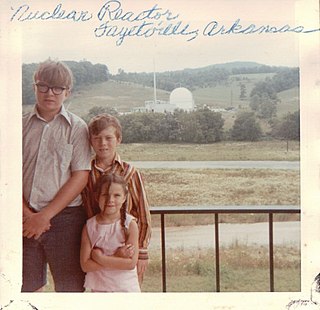
The Advanced Gas-cooled Reactor (AGR) is a type of nuclear reactor designed and operated in the United Kingdom. These are the second generation of British gas-cooled reactors, using graphite as the neutron moderator and carbon dioxide as coolant. They have been the backbone of the UK's nuclear power generation fleet since the 1980s.

Sellafield is a large multi-function nuclear site close to Seascale on the coast of Cumbria, England. As of August 2020, activities at the site include nuclear fuel reprocessing, nuclear waste storage and nuclear decommissioning, and it is a former nuclear power generating site. The licensed site covers an area of 265 hectares, and comprises more than 200 nuclear facilities and more than 1,000 buildings. It is Europe's largest nuclear site and has the most diverse range of nuclear facilities in the world situated on a single site.

The United Kingdom Atomic Energy Authority is a UK government research organisation responsible for the development of nuclear fusion power. It is an executive non-departmental public body of the Department for Business, Energy and Industrial Strategy (BEIS).

Dungeness nuclear power station is a pair of non-operational nuclear power stations located on the Dungeness headland in the south of Kent, England. Dungeness A is a legacy Magnox power station that was connected to the National Grid in 1965 and has reached the end of its life. Dungeness B is an advanced gas-cooled reactor (AGR) power station consisting of two 1,496 MWt reactors, which began operation in 1983 and 1985 respectively, and have been non-operational since 2018 with decommissioning beginning in 2021.

Dounreay is a small settlement and the site of two large nuclear establishments on the north coast of Caithness in the Highland area of Scotland. It is on the A836 road nine miles west of Thurso.

Idaho National Laboratory (INL) is one of the national laboratories of the United States Department of Energy and is managed by the Battelle Energy Alliance. While the laboratory does other research, historically it has been involved with nuclear research. Much of current knowledge about how nuclear reactors behave and misbehave was discovered at what is now Idaho National Laboratory. John Grossenbacher, former INL director, said, "The history of nuclear energy for peaceful application has principally been written in Idaho".
DIDO was a materials testing nuclear reactor at the Atomic Energy Research Establishment at Harwell, Oxfordshire in the United Kingdom. It used enriched uranium metal fuel, and heavy water as both neutron moderator and primary coolant. There was also a graphite neutron reflector surrounding the core. In the design phase, DIDO was known as AE334 after its engineering design number.

The Chernobyl Nuclear Power Plant (ChNPP), officially the Vladimir Lenin Nuclear Power Plant, is a closed nuclear power plant located near the abandoned city of Pripyat in northern Ukraine, 16.5 kilometers (10 mi) northwest of the city of Chernobyl, 16 kilometers (10 mi) from the Belarus–Ukraine border, and about 100 kilometers (62 mi) north of Kyiv. The plant was cooled by an engineered pond, fed by the Pripyat River about 5 kilometers (3 mi) northwest from its juncture with the Dnieper.

Chapelcross nuclear power station is a decommissioned and partly demolished Magnox nuclear power station near Annan in Dumfries and Galloway in southwest Scotland, which was in operation from 1959 to 2004. It was the sister plant to the Calder Hall plant in Cumbria, England; both were commissioned and originally operated by the United Kingdom Atomic Energy Authority. The primary purpose of both plants was to produce weapons-grade plutonium for the UK's nuclear weapons programme, but they also generated electrical power for the National Grid.

The Nuclear Decommissioning Authority (NDA) is a non-departmental public body of the Department for Business, Energy and Industrial Strategy, formed by the Energy Act 2004. It evolved from the Coal and Nuclear Liabilities Unit of the Department of Trade and Industry. It came into existence during late 2004, and took on its main functions on 1 April 2005. Its purpose is to deliver the decommissioning and clean-up of the UK's civil nuclear legacy in a safe and cost-effective manner, and where possible to accelerate programmes of work that reduce hazard. The NDA does not directly manage the UK's nuclear sites. It oversees the work through contracts with specially designed companies known as site licence companies. The NDA determines the overall strategy and priorities for managing decommissioning.

Wylfa nuclear power station is a decommissioned Magnox nuclear power station situated west of Cemaes Bay on the island of Anglesey, off the northwestern coast of Wales. Construction of the two 490 MW nuclear reactors, known as Reactor 1 and Reactor 2, began in 1963. They became operational in 1971. Wylfa was located on the coast because seawater was used as a coolant.

The Thermal Oxide Reprocessing Plant, or THORP, was a nuclear fuel reprocessing plant at Sellafield in Cumbria, England, now in the process of being decommissioned. THORP is owned by the Nuclear Decommissioning Authority and operated by Sellafield Ltd.

SEFOR was an experimental fast breeder reactor located in Cove Creek Township, Washington County, near Strickler, in northwest Arkansas. The site consisted of a 20-Megawatt (thermal), Sodium-Cooled Test Reactor, a Shop Building, an Operations Building, a Maintenance Shed, and an Electrical Transformer yard. It operated from 1969 to 1972 when the program ended. It was then acquired by the University of Arkansas, in hopes that it could be used as a research facility in 1975, but it never happened. The University maintained the decommissioned site until finally receiving federal funds to dismantle the facility in 2016, which completed in 2019.

Nuclear power in the United Kingdom generated 16.1% of the country's electricity in 2020. The UK has 11 operational nuclear reactors at five locations, as well as nuclear reprocessing plants at Sellafield and the Tails Management Facility (TMF) operated by Urenco in Capenhurst.

Nuclear decommissioning is the process whereby a nuclear facility is dismantled to the point that it no longer requires measures for radiation protection. The presence of radioactive material necessitates processes that are potentially occupationally hazardous, expensive, time-intensive, and present environmental risks that must be addressed to ensure radioactive materials are either transported elsewhere for storage or stored on-site in a safe manner. The challenge in nuclear decommissioning is not just technical, but also economical and social.

Hunterston B nuclear power station is a decommissioned nuclear power station in North Ayrshire, Scotland. Located about 6 miles (9.7 km) south of Largs and about 2.5 miles (4 km) north-west of West Kilbride on the Firth of Clyde coast. It is currently operated by EDF Energy, and began producing electricity in 1976. The station ceased generation and began defuelling on 7 January 2022.

Bradwell nuclear power station is a decommissioned Magnox-design nuclear power station located on the Dengie peninsula at the mouth of the River Blackwater, Essex. In 2019, it was the first nuclear power station in the UK to be placed into long-term decommissioned management. As of 2016, China General Nuclear Power Group and China National Nuclear Corporation are considering Bradwell for the site of a new nuclear power station.

The Sizewell nuclear site consists of two nuclear power stations, one of which is still operational, located near the small fishing village of Sizewell in Suffolk, England. Sizewell A, with two Magnox reactors, is now in the process of being decommissioned. Sizewell B has a single pressurised water reactor (PWR) and is the UK's newest nuclear power station. A third power station, to consist of twin EPR reactors, is planned to be built as Sizewell C.

Oldbury nuclear power station is a decommissioned Magnox nuclear power station located on the south bank of the River Severn close to the village of Oldbury-on-Severn in South Gloucestershire, England. The ongoing decommissioning process is managed by Magnox Ltd, a subsidiary of the Nuclear Decommissioning Authority (NDA). Oldbury is one of four stations located close to the mouth of the River Severn and the Bristol Channel, the others being Berkeley, Hinkley Point A, and Hinkley Point B.

Trawsfynydd nuclear power station is a decommissioned Magnox nuclear power station situated in Snowdonia National Park in Gwynedd, Wales. The plant, which became operational in 1965, was the only nuclear power station in the UK to be built inland, with cooling water that was taken from the man-made Llyn Trawsfynydd reservoir which also supplies the hydro-electric Maentwrog power station. It was closed in 1991. Its planned decommissioning by Magnox Ltd was expected to take almost 100 years, but in 2021 the Welsh government arranged for the power station to be redeveloped using small-scale reactors.


















